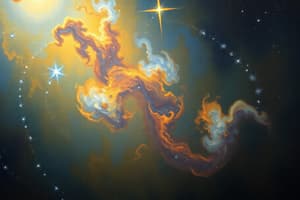Podcast
Questions and Answers
What is the primary cause of the periodic nova outbursts in T Coronae Borealis?
What is the primary cause of the periodic nova outbursts in T Coronae Borealis?
- Interactions between the two stars' magnetic fields
- The gravitational pull of nearby celestial bodies
- The red giant shedding material onto the white dwarf (correct)
- The consumption of hydrogen by the red giant
How often do nova outbursts occur in the T CrB system?
How often do nova outbursts occur in the T CrB system?
- Every 50 years
- Every 20 years
- Every 80 years (correct)
- Every 100 years
What was the last recorded nova outburst of T Coronae Borealis?
What was the last recorded nova outburst of T Coronae Borealis?
- 1986
- 1946 (correct)
- 1936
- 1966
What is the expected time frame for the next nova outburst of T CrB according to NASA?
What is the expected time frame for the next nova outburst of T CrB according to NASA?
What visual phenomenon will occur during the nova outburst of T CrB?
What visual phenomenon will occur during the nova outburst of T CrB?
What tools are recommended for a clearer view of the nova during its outburst?
What tools are recommended for a clearer view of the nova during its outburst?
Flashcards are hidden until you start studying
Study Notes
T Coronae Borealis (T CrB)
- T CrB is a binary star system, located 3,000 light-years from Earth.
- T CrB experiences periodic nova outbursts, occurring approximately every 80 years.
- The last outburst was in 1946.
- Nova outbursts are caused by a red giant and white dwarf in close orbit.
- The red giant sheds its outer layers onto the white dwarf, increasing pressure until a nova explosion occurs.
- NASA predicts that the next nova outburst will occur sometime before September 2024.
- The exact timing of the next outburst is difficult to predict, but it may occur soon, possibly within a couple of months before the end of summer.
- The nova will be visible to the naked eye for several days, appearing as a bright star in the northern sky.
- Binoculars will provide a clearer view of the nova for a week.
Studying That Suits You
Use AI to generate personalized quizzes and flashcards to suit your learning preferences.




